Start the Evolution client.
GNOME: |
Click Programs > Evolution. |
KDE: |
Click the red N at the bottom panel > Office > Evolution. |
Command Line: |
Enter evolution. |
The first time you run Evolution, it creates a directory called .evolution in your home directory, where it stores all of its local data. Then, it opens a First-Run Assistant to help you set up e-mail accounts and import data from other applications.
Using the first-run assistant takes two to five minutes.
Later on, if you want to change this account, or if you want to create a new one, click Tools > Settings, then click Mail Accounts. Select the account you want to change, then click Edit. Alternately, add a new account by clicking Add. See Mail Preferences for details.
The First-Run Assistant help you provide the information Evolution needs to get started.
The Identity window is the first step in the assistant.
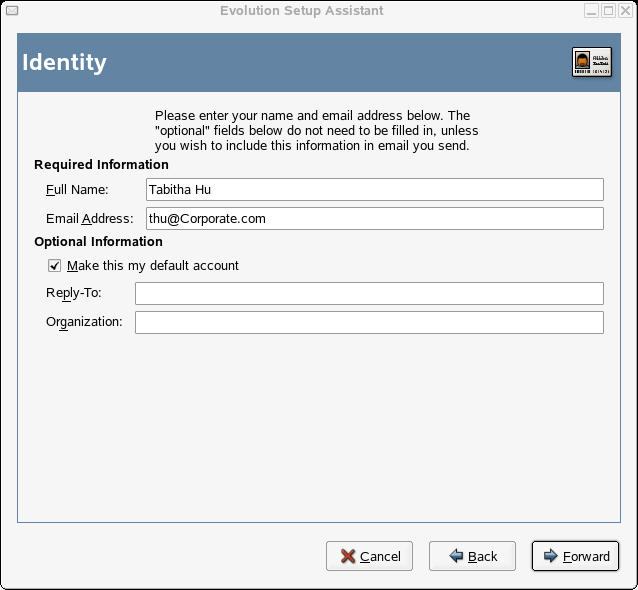
Here, you enter some basic personal information. You can define multiple identities later by clicking Tools > Settings, then click Mail Accounts.
When the First-Run Assistant starts, the Welcome page is displayed. Click Forward to proceed to the Identity window.
Type your full name in the Full Name field.
Type your e-mail address in the E-Mail Address field.
(Optional) Select if this account is your default account.
(Optional) Type a reply to address in the Reply-To field.
Use this field if you want replies to e-mails sent to a different address.
(Optional) Type your organization in the Organization field.
The company where you work, or the organization you represent when you send e-mail.
Click Forward.
The Receiving E-mail option lets you determine where you get your e-mail.
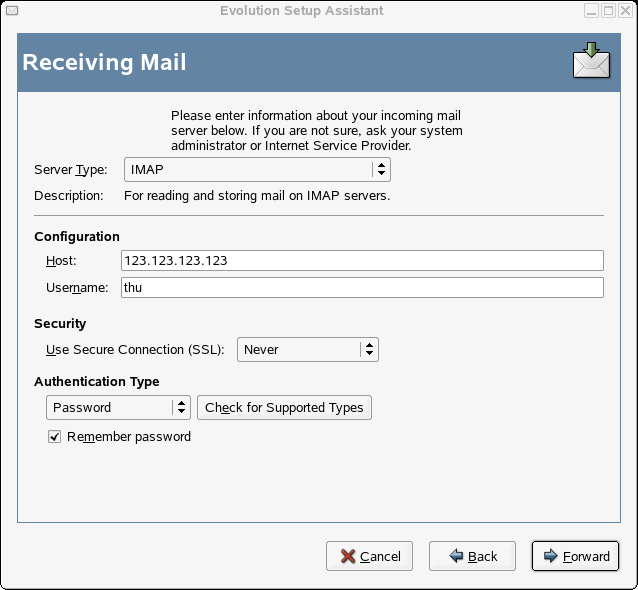
You need to specify the type of server you want to receive mail with. If you are unsure about the type of server to choose, ask your system administrator or ISP.
Select a server type in the Server Type list.
The following a list of server types that are available:
Microsoft Exchange: Available only if you have installed the Connector for Microsoft* Exchange. It allows you to connect to a Microsoft Exchange 2000 or 2003 server, which stores e-mail, calendar, and contact information on the server. For configuration instructions, see Remote Configuration Options.
IMAP: Keeps the e-mail on your server so you can access your e-mail from multiple systems. For configuration instructions, see Remote Configuration Options.
POP: Downloads your e-mail to your hard disk for permanent storage, freeing up space on the e-mail server. For configuration instructions, see Remote Configuration Options.
USENET News: Connects to the news server and downloads a list of available news digests. For configuration instructions, see Remote Configuration Options.
Local Delivery: Choose this option if you want to move e-mail from the spool (the location where mail waits for delivery) and store it in your home directory. You need to provide the path to the mail spool you want to use. If you would rather leave e-mail in your system's spool files, choose the Standard Unix Mbox Spool option instead. For configuration instructions, see Local Configuration Options.
MH Format Mail Directories: If you download your e-mail using mh or another MH-style program, you should use this option. You need to provide the path to the mail directory you want to use. For configuration instructions, see Local Configuration Options.
Maildir Format Mail Directories: If you download your e-mail using Qmail or another maildir-style program, you should use this option. You need to provide the path to the mail directory you want to use. For configuration instructions, see Local Configuration Options.
Standard Unix Mbox Spool or Directory: If you want to read and store e-mail in the mail spool on your local system, choose this option. You need to provide the path to the mail spool you want to use. For configuration instructions, see Local Configuration Options.
None: Select this if you do not plan to check e-mail with this account. If you select this, there are no configuration options.
If you selected Microsoft Exchange, IMAP, POP, or USENET News as your server, you'll need to specify additional information.
Type the hostname of your e-mail server in the Hostname field.
If you don't know the hostname, contact your administrator.
Type your username for the account in the Username field.
Select to use a secure (SSL) connection.
If your server supports secure connections, you should enable this security option. If you are unsure your server supports a secure connection, contact your system administrator.
Select your authentication type in the Authentication list.
or
Click Check for Supported Types to have Evolution check for supported types. Some servers do not announce the authentication mechanisms they support, so clicking this button is not a guarantee that available mechanisms actually work.
If you are unsure what authentication type you need, contact your system administrator.
Select if you want Evolution to remember your password.
Click Forward.
When you have finished, continue with Receiving Mail Options.
If you selected Local Delivery, MH-Format Mail Directories, Maildir-Format Mail Directories, or Standard Unix Mbox Spool or Directory, you must specify the path to the local files in the path field. Continue with Receiving Mail Options.
After you have selected a mail delivery mechanism, you can set some preferences for its behavior.
If you select Microsoft Exchange as your receiving server type, you need to specify the following options.
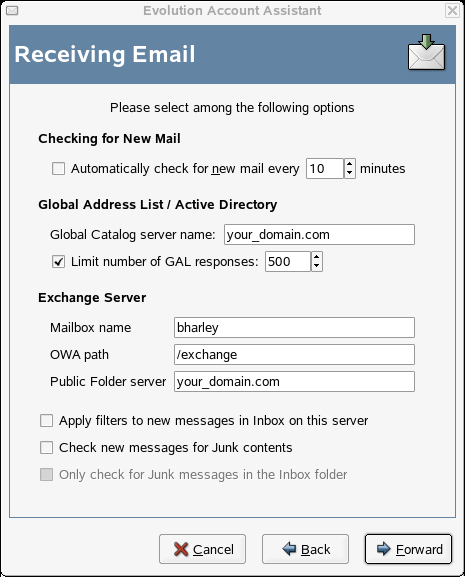
Select if you want Evolution to automatically check for new mail.
If you select this option, you need to specify how often Evolution should check for new messages.
Specify the Global Catalog server name in the Global Catalog Server Name field.
The Global Catalog Server contains the user information for users. If you are unsure what your Global Catalog server name is, contact your system administrator.
Select if you want to limit the number of Global Address Lists (GAL).
The GAL contains a list of all e-mail addresses. If you select this option, you need to specify the maximum number of responses.
Specify the mailbox name in the Mailbox Name field.
If you are unsure what your mailbox name is, contact your system administrator.
Specify the Outlook Web Access (OWA) path in the OWA Path field.
The OWA allows any client with a compatible browser to access Exchange Server folders. If you are unsure about the location of your OWA, contact your system administrator.
Specify the address of the Public Folder server in the Public Folder Server field.
The Public Folder server, contains all folders that are public on the Exchange system. If you are unsure of the address for your public folder server, contact your system administrator.
Select if you want to apply filters to new messages in the Inbox on the server.
For additional information on filtering, see Creating New Filter Rules.
Select if you want to check new messages for junk contents.
For additional information on junk content, see Junk Mail Preferences.
Select if you want to check for junk messages in the Inbox folder.
Click Forward.
When you have finished, continue with Sending Mail.
If you select IMAP as your receiving server type, you need to specify the following options.
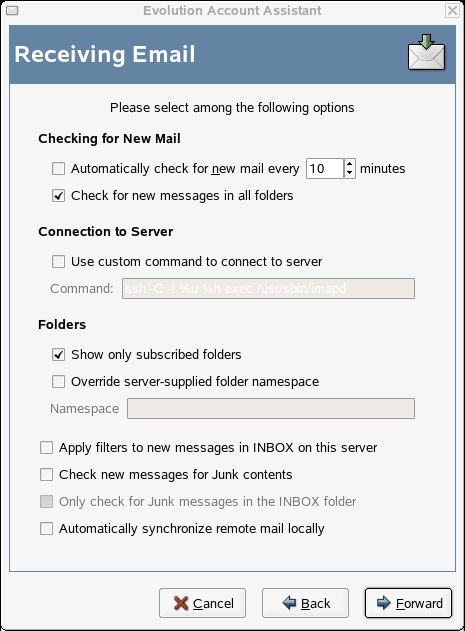
Select if you want Evolution to automatically check for new mail.
If you select this option, you need to specify how often Evolution should check for new messages.
Select if you want Evolution to use custom commands to connect to Evolution.
If you select this option, specify the custom command you want Evolution to use.
Select if you want Evolution to show only subscribed folders.
Subscribed folders are folders that you have chosen to receive mail from by subscribing to them.
Select if you want Evolution to override server-supplied folder namespaces.
By choosing this option you can rename the folders that the server provides. If you select this option, you need to specify the namespace to use.
Select if you want to apply filters to new messages in the Inbox.
For additional information on filtering, see Creating New Filter Rules.
Select if you want to check new messages for junk content.
For additional information on junk content, see Junk Mail Preferences.
Select if you want to check for junk messages in the Inbox folder.
Select if you want to automatically synchronize remote mail locally.
Click Forward.
When you have finished, continue with Sending Mail.
If you select POP as your receiving server type, you need to specify the following options.
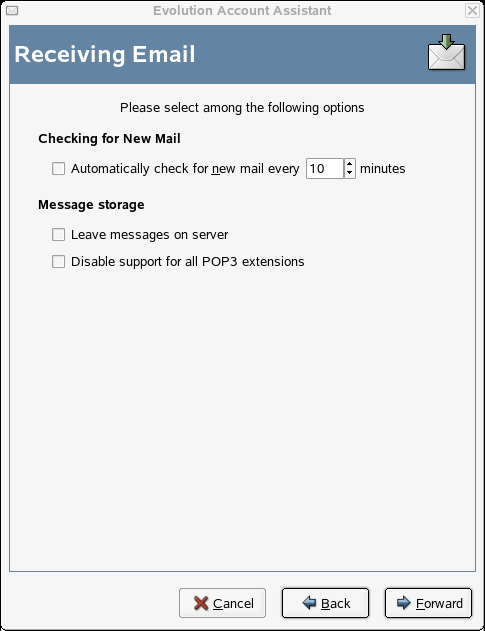
Select if you want Evolution to automatically check for new mail.If you select this option, you need to specify how often Evolution should check for new messages.
Select if you want to leave messages on the server.
Select if you want to disable support for all POP3 extensions (support for POP3).
Click Forward.
When you have finished, continue with Sending Mail.
If you select USENET News as your receiving server type, you need to specify the following options.
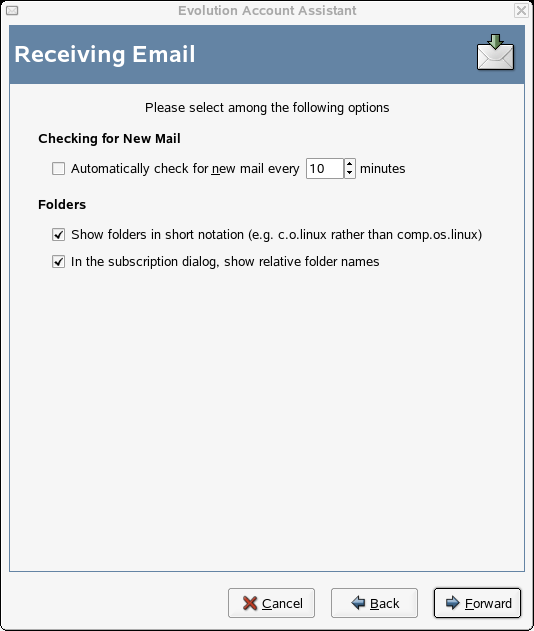
Select if you want Evolution to automatically check for new mail.If you select this option, you need to specify how often Evolution should check for new messages.
Select if you want to show folders in short notation.
For example, comp.os.linux would appear as c.o.linux.
Select if you want to show relative folder names in the subscription dialog box.
If you select to show relative folder names in the subscription page, only the name of the folder is displayed. For example the folder evolution.mail would appear as evolution.
Click Forward.
When you have finished, continue with Sending Mail.
If you select Local Delivery as your receiving server type, you need to specify the following options.
Select if you want Evolution to automatically check for new mail.If you select this option, you need to specify how often Evolution should check for new messages.
Click Forward.
When you have finished, continue with Sending Mail.
If you select MH-Format Mail Directories as your receiving server type, you need to specify the following options.
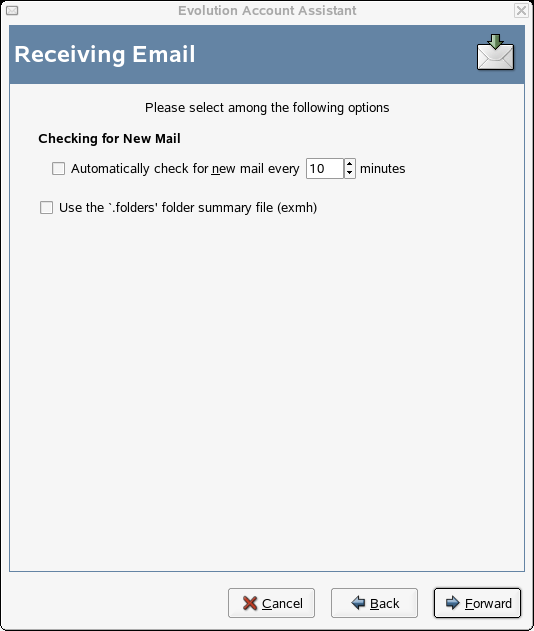
Select if you want Evolution to automatically check for new mail.If you select this option, you need to specify how often Evolution should check for new messages.
Select if you want to user the .folders folder summary file.
Click Forward.
When you have finished, continue with Sending Mail.
If you select Maildir-Format Mail Directories as your receiving server type, you need to specify the following options.
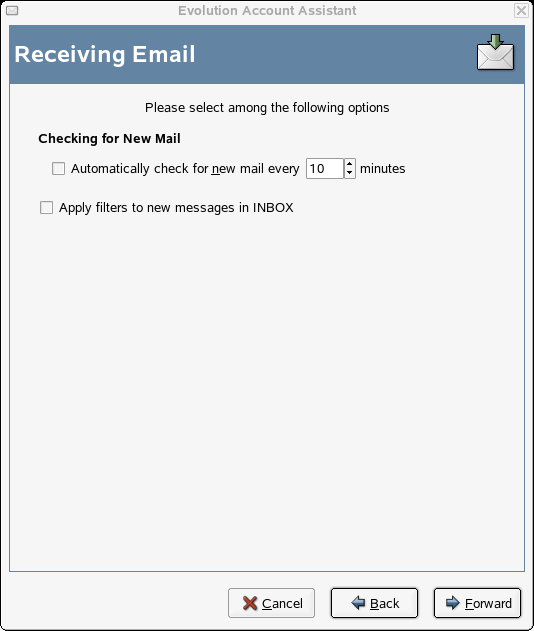
Select if you want Evolution to automatically check for new mail.If you select this option, you need to specify how often Evolution should check for new messages.
Select if you want to apply filters to new messages in the Inbox.
For additional information on filtering, see Creating New Filter Rules.
Click Forward.
When you have finished, continue with Sending Mail.
If you select Standard Unix Mbox Spool or Directory as your receiving server type, you need to specify the following options.
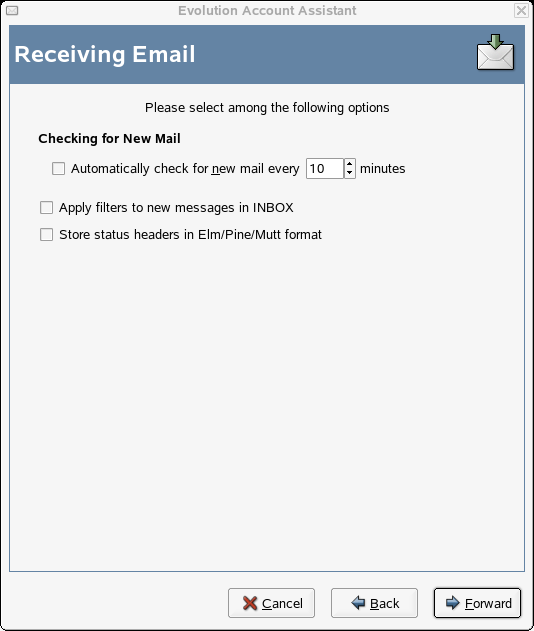
Select if you want Evolution to automatically check for new mail.If you select this option, you need to specify how often Evolution should check for new messages.
Select if you want to apply filters to new messages in the Inbox.
Select if you want to store status headers in Elm, Pine, and Mutt formats.
Click Forward.
When you have finished, continue with Sending Mail.
Now that you have entered information about how you plan to get mail, Evolution needs to know about how you want to send it.
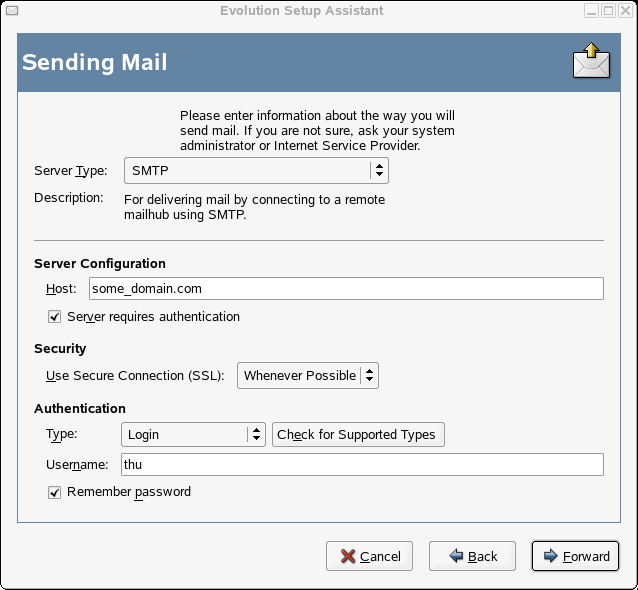
Select a server type from the Server Type list.
The following server types are available:
Microsoft Exchange: Uses Microsoft Exchange to send mail from the system.
Sendmail: Uses the Sendmail program to send mail from your system. Sendmail is more flexible, but is not as easy to configure, so you should select this option only if you know how to set up a Sendmail service.
SMTP: Sends mail using an outbound mail server. This is the most common choice for sending mail. If you choose SMTP, there are additional configuration options. See SMTP Configuration for more information.
Type the host address in the Host field.
If you are unsure what your host address is, contact your system administrator.
Select if your server requires authentication.
If you selected that your server requires authentication, you will need to provide the following information:
Select your authentication type in the Authentication list.
or
Click Check for Supported Types to have Evolution check for supported types. Some servers do not announce the authentication mechanisms they support, so clicking this button is not a guarantee that available mechanisms actually work.
Type your username in the Username field.
Select if you want Evolution to remember your password.
Select if you use a secure connection (SSL).
Click Forward.
Continue with Account Management.
Now that you have finished the e-mail configuration process you need to give the account a name. The name can be any name you prefer. Type your account name on the Name field, then click Forward.
Continue with Timezone.
In this step, you need to select your time zone either on the map or select from the time zone drop-down list.
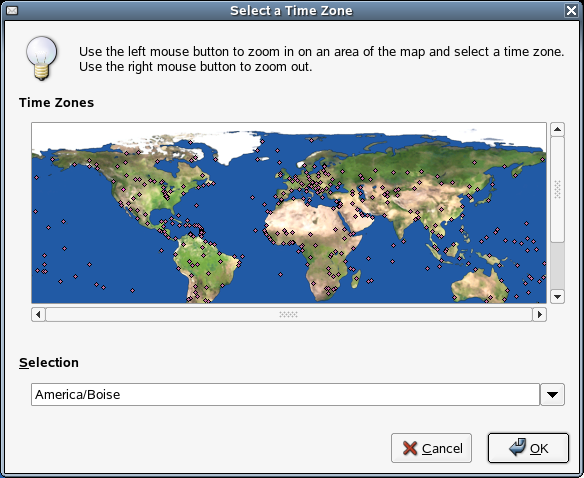
When you have finished, click Forward, then Apply. Evolution will open with your new account created.
If you want to import e-mail from another e-mail client, continue with Importing Mail. If not, skip to Using Evolution: An Overview.
If Evolution finds e-mail or address files from another application, it offers to import them. For a full description of the import feature, see Importing Single Files.
Microsoft Outlook*, and versions of Outlook Express after version 4, use proprietary formats that Evolution cannot read or import. To import information, you may want to use the Export tool under Windows. See the instructions in Migrating Local Outlook Mail Folders.
Before importing e-mail from Netscape*, make sure you have selected File > Compact All Folders. If you don't, Evolution will import and undelete the messages in your Trash folders.
HINT: Exporting Files From Evolution
Evolution uses standard file types for e-mail and calendar information, so you can copy those files from your ~/.evolution directory. The file formats used are mbox for e-mail and iCal for calendar information.
Contacts files are stored in a database, but can be saved as a standard vCard*. To export contact data, open your contacts tool and select the contacts you want to export (press Ctrl+A to select them all). Click File > Save as VCard.